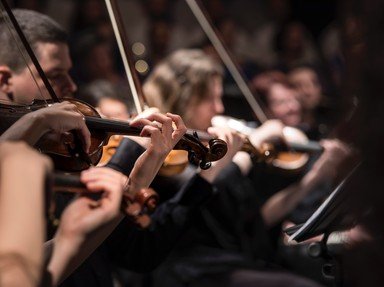Quiz Answer Key and Fun Facts
1. Nancarrow was one of the most innovative American composers of the twentieth century. He's particularly noted for his unplayable piano music--written for player piano instead. What was his first name?
2. Grainger is probably the most well-known Australian composer. He was an extremely gifted pianist and an amateur saxophonist as well. His most famous pieces are his folk song arrangements of 'Danny Boy' and the piece for concert band, "Lincolnshire Posy". What name did his mommy give him?
3. Wolf was an Austrian composer known mainly for his lieder. He is often grouped with Bruckner, Mahler and Richard Strauss as one of the great Post-Romantic composers. What was his given name?
4. Ysaye was a great Belgian violinist and composer. His set of six sonatas for unaccompanied violin are seen alongside Bach's "Sonatas and Partitas" and the "24 Caprices" of Paganini as being the finest of their kind. What was his first name?
5. Villa-Lobos is certainly the most well-known Brazilian composer. The "Aria" from his "Bachianas Brasilieras no.5", for wordless soprano and eight cellos, is his most famous piece. What was his first name?
6. Along with Bedrich Smetana, Antonin Dvorak and Leos Janacek, Martinu is considered one of the greatest Czech composers. What was his given name?
7. "A Child of Our Time" is probably Tippett's most well-known work. What is this sir's given name?
8. Messiaen wrote "Quartet for the End of Time" whilst interred in a Nazi prisoner-of-war camp. Later works, such as "Turangalila-Symphonie", cemented his reputation as one of the greatest and most unique composers of the twentieth century. What was Messiaen's first name?
9. Franz Liszt and Bela Bartok are undoubtedly the most famous Hungarian composers. But Kodaly is also an important figure in Hungarian music as well as in the field of music education. What was his given name?
10. Italy has produced many very famous composers, particularly in the Baroque era (Vivaldi, Corelli etc.), the opera world (Verdi, Rossini etc.) and avant-garde music (Berio, Nono, Maderna etc.). But there have been several noted film composers also. One is Morricone. What is his first name?
11. Japan has produced several noted composers of Western classical music. The most famous is probably Takemitsu. What is his given name?
12. Mexican artists such as Diego Rivera and Frida Kahlo are very famous, but classical composers from Mexico are less well known. One is Carlos Chavez. Another is Revueltas. What is Revueltas's first name?
13. Some of the most famous composers ever have been Russian: Tchaikovsky, Mussorgsky, Rachmaninov, Stravinsky, Shostakovich, Prokofiev. But to ask their first names would be too easy! How about Balakirev's?
14. The Spanish composer, Rodrigo, wrote one of the most enduringly popular classical concertos ever, the guitar concerto "Concierto de Aranjuez". What was his first name?
15. Switzerland is famous for its mountains, cuckoo clocks, chocolate, bank accounts and neutrality. Most people would be hard pressed to name a single Swiss artist. Arthur Honegger, composer of "Pacific 231", was Swiss. So was Martin, whose name sounds decidedly un-French if pronounced as an English-speaker might be tempted. What was Martin's first name?
Source: Author
MarcelMule
This quiz was reviewed by FunTrivia editor
ralzzz before going online.
Any errors found in FunTrivia content are routinely corrected through our feedback system.

